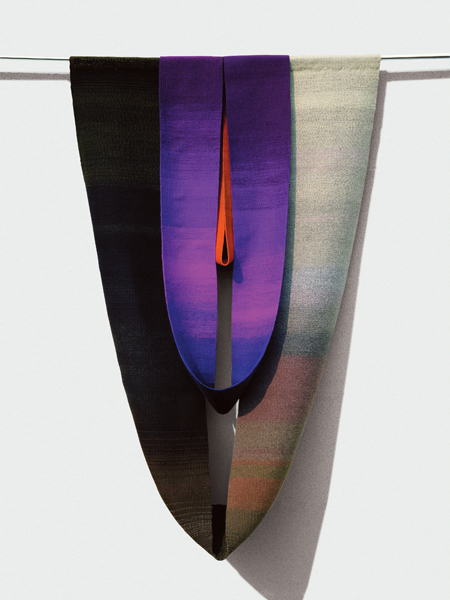Decorum

My visit to Paris coincided with English rugby fans politely invading the French capital, with young men and women from across the Channel occupying every bar. Luckily ‘Decorum’ provided a more refreshing example of well-heeled ostentation, and it was immediately clear that the exhibition – whose intentionally pompous title was chosen as a foil for political and aesthetic risk-taking – was produced as an ‘itinerary in reverse’, a thematic rather than chronological selection from contemporary tapestries, rugs and woven works of the recent neo-craft tendency, back through the 3D new tapestry movement of the 1960s, the bauhaus, art deco and the arts and crafts movement, to oriental and primitive creations.
The curator, Anne Dressen, stated that her intention was to address current disjunctions within contemporary art, where design and the decorative remain ‘minor’ art forms. This attempt to rescue tapestry by celebrating its laboriously slow craft tradition was convincing on paper, yet the subject is more complex than simple oppositions, with contemporary woven works integrating the latest technological modes of production.
Aside from featuring historical heavyweights such as Francis Bacon, Fernand Léger and Pablo Picasso, the introductory section that dealt with the relationship between modern painting and textiles also included contemporary works by artists such as Gillian Carnegie and Albert Oehlen. Walking around Carnegie’s fantastic Nu assoupi (Sleepy Nude, 2009) was so disorientating that I had to steady myself, its off-centre optical pattern a revenge on geometric abstraction. And, as a raw death mask that stares out at the viewer, Oehlen’s large Untitled (2000–04) is haunting. If carpets pre-date cave paintings – cave dwellers would have lined their dwellings with animal skins, detritus and leaves – then perhaps these works are an anxious return of the pre-painterly repressed.
The section on ‘the decorative’ confronted the legacy of utopian movements that utilized the warp and weft. Tauba Auerbach’s Split-Slice II (2013), a white, geometric Secession-like work, was beautifully bamboozling in its structural complexity, while the story of Omega Workshop’s Ideal Home Exhibition Rug (1913), designed by Frederick Etchells, was fascinating: the famously conservative Daily Mail Ideal Home Exhibition, held at Olympia, London, invited the avant-garde Omega group to take part in the hope that their contribution would cause outrage.
Shown next to each other, Robert Camille Quesnel’s Paravent (1925), a three-panelled screen, and Marc Camille Chaimowicz’s Dual (2006–07), a pair of day-beds, presented a touching link between two artists from different generations. Having been asked to design the exhibition with architect Christine Ilex Beinemeier, Chaimowicz’s presence was clear, in everything from the catalogue’s sketched dividers to the impish scenography, customized so that secondary ‘props’ became a focus of attention. This made for mesmerizing viewing, especially with aesthetics professor Jean-Philippe Antoine selecting a soundtrack – or ‘furnishing music’ – that created an all-consuming domestic installation, which bled from one room to another. Products of the Bowie generation, Chaimowicz’s works are famously androgynous and occupy an indeterminate area that could be described as political, prioritizing media that have traditionally been perceived as feminine and blending elements from the home, city and museum to create a wonderfully glamorous form of museological critique.
The section dedicated to the woven work as sculptural form was the exhibition’s most powerful as it explored the ‘emancipation’ of carpets from their two-dimensional domestic state. Yet, despite the formal rigour of works such as Sheila Hicks’s Menhir – She (1998–2004), disturbing pieces by Mike Kelley (Daisy Blanket, 1990) and Vidya Gastaldon (God Mother [baba], 2006) proved more naturally convincing and transgressive. Gastaldon’s absurd cartoon cyclops, with its woollen heart in full view, and Kelley’s grubby doll, with its lurking mound of a midriff, sat well alongside Wojciech Sadley’s The Queen (1964), another preposterously reductive feminine totem with a dress-like contour constructed from metal, wood and rope. Accompanied by a soundtrack that comprised Sun Ra’s Dance of the Cosmo-Aliens (1978), a track from David Crosby’s album If I could only remember my name (1971) and Kelley’s own Tijuana Hayride (2005), other imaginary narratives were triggered to complicate things further, before the enormous Auditorium (1992) by Franz West and Michael Beutler’s Weaving Workshop (2009–13), (a massive weaving loom) performed an extravagant full-stop.
If tapestries go beyond the limitations of interior decoration – Le Corbusier described them as ‘Muralnomad’ – this exhibition dealt with many vital reversals of expectation, intelligently levelling medium-specific hierarchies to suggest new possibilities for the future of woven works.















